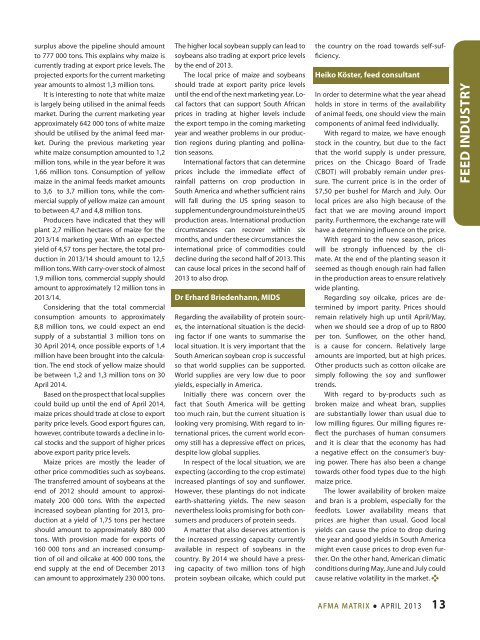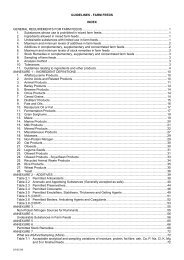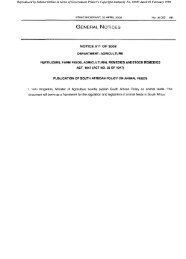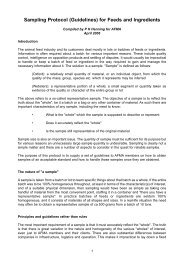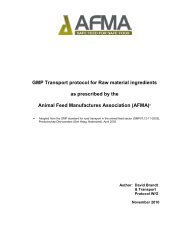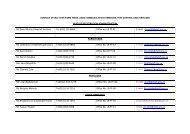Create successful ePaper yourself
Turn your PDF publications into a flip-book with our unique Google optimized e-Paper software.
surplus above the pipeline should amount<br />
to 777 000 tons. This explains why maize is<br />
currently trading at export price levels. The<br />
projected exports for the current marketing<br />
year amounts to almost 1,3 million tons.<br />
It is interesting to note that white maize<br />
is largely being utilised in the animal feeds<br />
market. During the current marketing year<br />
approximately 642 000 tons of white maize<br />
should be utilised by the animal feed market.<br />
During the previous marketing year<br />
white maize consumption amounted to 1,2<br />
million tons, while in the year before it was<br />
1,66 million tons. Consumption of yellow<br />
maize in the animal feeds market amounts<br />
to 3,6 to 3,7 million tons, while the commercial<br />
supply of yellow maize can amount<br />
to between 4,7 and 4,8 million tons.<br />
Producers have indicated that they will<br />
plant 2,7 million hectares of maize for the<br />
<strong>2013</strong>/14 marketing year. With an expected<br />
yield of 4,57 tons per hectare, the total production<br />
in <strong>2013</strong>/14 should amount to 12,5<br />
million tons. With carry-over stock of almost<br />
1,9 million tons, commercial supply should<br />
amount to approximately 12 million tons in<br />
<strong>2013</strong>/14.<br />
Considering that the total commercial<br />
consumption amounts to approximately<br />
8,8 million tons, we could expect an end<br />
supply of a substantial 3 million tons on<br />
30 <strong>April</strong> 2014, once possible exports of 1,4<br />
million have been brought into the calculation.<br />
The end stock of yellow maize should<br />
be between 1,2 and 1,3 million tons on 30<br />
<strong>April</strong> 2014.<br />
Based on the prospect that local supplies<br />
could build up until the end of <strong>April</strong> 2014,<br />
maize prices should trade at close to export<br />
parity price levels. Good export figures can,<br />
however, contribute towards a decline in local<br />
stocks and the support of higher prices<br />
above export parity price levels.<br />
Maize prices are mostly the leader of<br />
other price commodities such as soybeans.<br />
The transferred amount of soybeans at the<br />
end of 2012 should amount to approximately<br />
200 000 tons. With the expected<br />
increased soybean planting for <strong>2013</strong>, production<br />
at a yield of 1,75 tons per hectare<br />
should amount to approximately 880 000<br />
tons. With provision made for exports of<br />
160 000 tons and an increased consumption<br />
of oil and oilcake at 400 000 tons, the<br />
end supply at the end of December <strong>2013</strong><br />
can amount to approximately 230 000 tons.<br />
The higher local soybean supply can lead to<br />
soybeans also trading at export price levels<br />
by the end of <strong>2013</strong>.<br />
The local price of maize and soybeans<br />
should trade at export parity price levels<br />
until the end of the next marketing year. Local<br />
factors that can support South African<br />
prices in trading at higher levels include<br />
the export tempo in the coming marketing<br />
year and weather problems in our production<br />
regions during planting and pollination<br />
seasons.<br />
International factors that can determine<br />
prices include the immediate effect of<br />
rainfall patterns on crop production in<br />
South America and whether sufficient rains<br />
will fall during the US spring season to<br />
supplement underground moisture in the US<br />
production areas. International production<br />
circumstances can recover within six<br />
months, and under these circumstances the<br />
international price of commodities could<br />
decline during the second half of <strong>2013</strong>. This<br />
can cause local prices in the second half of<br />
<strong>2013</strong> to also drop.<br />
Dr Erhard Briedenhann, MIDS<br />
Regarding the availability of protein sources,<br />
the international situation is the deciding<br />
factor if one wants to summarise the<br />
local situation. It is very important that the<br />
South American soybean crop is successful<br />
so that world supplies can be supported.<br />
World supplies are very low due to poor<br />
yields, especially in America.<br />
Initially there was concern over the<br />
fact that South America will be getting<br />
too much rain, but the current situation is<br />
looking very promising. With regard to international<br />
prices, the current world economy<br />
still has a depressive effect on prices,<br />
despite low global supplies.<br />
In respect of the local situation, we are<br />
expecting (according to the crop estimate)<br />
increased plantings of soy and sunflower.<br />
However, these plantings do not indicate<br />
earth-shattering yields. The new season<br />
nevertheless looks promising for both consumers<br />
and producers of protein seeds.<br />
A matter that also deserves attention is<br />
the increased pressing capacity currently<br />
available in respect of soybeans in the<br />
country. By 2014 we should have a pressing<br />
capacity of two million tons of high<br />
protein soybean oilcake, which could put<br />
the country on the road towards self-sufficiency.<br />
Heiko Köster, feed consultant<br />
In order to determine what the year ahead<br />
holds in store in terms of the availability<br />
of animal feeds, one should view the main<br />
components of animal feed individually.<br />
With regard to maize, we have enough<br />
stock in the country, but due to the fact<br />
that the world supply is under pressure,<br />
prices on the Chicago Board of Trade<br />
(CBOT) will probably remain under pressure.<br />
The current price is in the order of<br />
$7,50 per bushel for March and July. Our<br />
local prices are also high because of the<br />
fact that we are moving around import<br />
parity. Furthermore, the exchange rate will<br />
have a determining influence on the price.<br />
With regard to the new season, prices<br />
will be strongly influenced by the climate.<br />
At the end of the planting season it<br />
seemed as though enough rain had fallen<br />
in the production areas to ensure relatively<br />
wide planting.<br />
Regarding soy oilcake, prices are determined<br />
by import parity. Prices should<br />
remain relatively high up until <strong>April</strong>/May,<br />
when we should see a drop of up to R800<br />
per ton. Sunflower, on the other hand,<br />
is a cause for concern. Relatively large<br />
amounts are imported, but at high prices.<br />
Other products such as cotton oilcake are<br />
simply following the soy and sunflower<br />
trends.<br />
With regard to by-products such as<br />
broken maize and wheat bran, supplies<br />
are substantially lower than usual due to<br />
low milling figures. Our milling figures reflect<br />
the purchases of human consumers<br />
and it is clear that the economy has had<br />
a negative effect on the consumer’s buying<br />
power. There has also been a change<br />
towards other food types due to the high<br />
maize price.<br />
The lower availability of broken maize<br />
and bran is a problem, especially for the<br />
feedlots. Lower availability means that<br />
prices are higher than usual. Good local<br />
yields can cause the price to drop during<br />
the year and good yields in South America<br />
might even cause prices to drop even further.<br />
On the other hand, American climatic<br />
conditions during May, June and July could<br />
cause relative volatility in the market.<br />
Feed industry<br />
<strong>AFMA</strong> MATRIX ● APRIL <strong>2013</strong> 13


